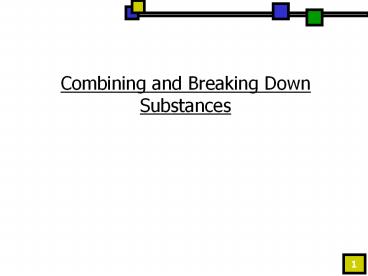Combining and Breaking Down Substances PowerPoint PPT Presentation
1 / 20
Title: Combining and Breaking Down Substances
1
Combining and Breaking Down Substances
2
Compounds Mixtures
- What happens when you combine two or more
substances?
1. Compounds is a substance that is made from
two or more simple substances that can be broken
down by chemical means.
a compound always contains two or more
elements joined in fixed proportions.
2. Mixture is a physical combination of two
or more substances.
a mixture does not have a set number of
elements joined in fixed proportions.
3
Types of mixtures
- There are two types of mixtures
1. Heterogeneous Mixtures the parts of the
mixture are noticeably different from one
another.
ex. sand or gravel
2. Homogeneous Mixtures the substances are so
evenly distributed that is difficult to
distinguish one from another.
Solution a mixture that forms when a
substance dissolves (solute) in a liquid
(solvent) and forms a homogeneous mixture.
4
A little review
- Compounds are much more complex than mixtures.
- We will have to review the structure of an atom
to understand how compounds work.
5
Electron Structures of Atoms
nucleus
1st energy level
1st Period Hydrogen (1) Helium (2)
2nd energy level
2nd Period Lithium (3) Neon (10)
6
- Elements in the same group have similar
properties because they have same number of
valence electrons (e- in outermost shell). - The number of valence electrons increases as you
go from left to right across a period there is
no change going down a group. - Ex Alkali metals all have one valence electron
they all will form a white powder with cl.
7
Lewis structures of atoms
- Lewis structure shows only valence e- of an atom
or ion. - Uses dots, representing e-, at top, bottom,
right, and left sides - Ex Carbon (6 e-) Fluorine (9 e-)
Valence e-
C
F
Element symbol
8
Lewis structures of first 20 elements
- Most elements want a set of valence electrons
like that of the chemically-stable noble gases,
which have 8 valence electrons- (except He)
9
Chemical Bonds
- Chemical bond force that holds atoms or ions
together - Interaction occurs between valence electrons
- Examples ionic, covalent
- Chemical formula shows the elements in a
compound and the ratio of the atoms in the
compound - Example formula for water is H20
10
Ionic Compounds
- When one or more e- are transferred from a metal
atom to a nonmetal atom, ions are formed. - Ionic bond attractive force between oppositely
charged ions
..
..
.
Na atom Cl atom ? Na Cl sodium
chloride
..
.
11
..
..
Mg atom 2 Cl atom ? Mg 2 Cl magnesium
chloride
.
..
12
Covalent Compounds
- Covalent bonds occur in most natural compounds
like methane (CH4), ammonia (NH3), and large
biological molecules (proteins, DNA, etc.) - Nonmetal atoms still want to have filled e-
levels, but instead of transferring e- and
forming ions, they share e-, forming a covalent
bond. (Co-valent means sharing valence.)
13
- Substances with covalent bonds exist as molecules
(combinations of at least 2 nonmetal atoms)
O-C-O
14
The simplest molecule H2
The 1st energy levels of the H atoms overlap.
15
Hydrogen chloride molecule, HCl
- If the elements are not the same, the bond is
polar covalent the electrons are shared
unequally.
16
Chemical Reactions
- Just as we can classify matter, we can classify
chemical reactions.
- Some of the general types of reactions follow
1. Synthesis Reaction- is a reaction in which
two or more substances react to form a single
substance.
ex. Na Cl ? NaCl ex. 2H2 O2 ? 2H2O
2. Decomposition Reaction- Opposite of a
synthesis reaction. This a reaction in which a
compound breaks down into two or more simpler
substances.
ex. 2H2O ? 2H2 O2
17
Chemical Reactions Cont.
1. Replacement Reaction- is a reaction in which
one or more elements take the place of one or
more elements in a compound, resulting in a new
compound.
ex. Cu 2AgNO3 ? 2Ag Cu(NO3)2
18
Chemical Reactions Cont.
4. Combustion Reactions is a reaction in
which a substance reacts rapidly with oxygen,
which often produces heat and light.
ex. CH4 2O2 ? CO2 2H2O heat light
19
Factors that effect Reactions
- Reaction rates depend on how often the particles
collide. - If the collisions occur more often the rate will
increase and vice versa. - Factors that affect reaction rates include the
following
1. Temperature - Generally, an increase in
temperature will increase a reaction rate.
ex. milk stored in a refrigerator -vs- on the
counter
2. Surface Area The more area exposed the
faster the reaction will be.
20
Factors that effect Reactions Cont.
3. Stirring Also increases the exposure of
reactants to each other.
ex. washing machine
4. Concentration The more reactants, the
faster the particles will react.
ex. dye solution concentration
5. Catalysts is a substance that affects the
reaction rate without being used up in the
reaction.
Used to speed up reactions or have a reaction
occur at a lower temperature.
Weakens the bonds holding substance together.

